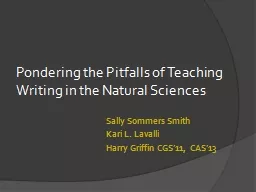

Sally Sommers Smith Kari L Lavalli Harry Griffin CGS11 CAS13 Background Proficiency with reading and writing is fundamental to being a good student and a good worker in nearly any field Student writing however typically is directed towards the instructor solely for the purpose of ass ID: 495535
Download Presentation The PPT/PDF document "Pondering the Pitfalls of Teaching Writi..." is the property of its rightful owner. Permission is granted to download and print the materials on this web site for personal, non-commercial use only, and to display it on your personal computer provided you do not modify the materials and that you retain all copyright notices contained in the materials. By downloading content from our website, you accept the terms of this agreement.
Slide1
Pondering the Pitfalls of Teaching Writing in the Natural Sciences
Sally Sommers Smith
Kari L. Lavalli
Harry Griffin CGS’11, CAS’13Slide2
Background
Proficiency with reading and writing is fundamental to being a good student and a good worker in nearly any field
Student writing, however, typically is directed towards the instructor solely for the purpose of assessment (Britton et al. 1979)Slide3
Writing Process
Writing process consists of 3 metacognitive actions:
Planning
Translating
Revising
For proficient writers, the revision process should allow for assessment of writing, finding of errors, and formulating changes that lead to both expression of understanding and understanding of the subject matter itselfSlide4
Experiment
Year 1:
Two papers assigned
First paper on free form inquiry-based, 2 week lab, driven by students’ own questions
Students given 2 weeks to write paper
Paper graded, returned, students given opportunity to revise
Second paper on structured inquiry-like experiment, 2 week lab on fruit fly mating behavior and genetics
Students given 2 weeks to write paper; no rewriteSlide5
Science Writing Described –
Aid to PlanningSlide6
Grading Rubric Provided (Aid to Planning & Translating)Slide7
Sample Paper Illustrating Sections and References Cited Provided (Aid to Translating)Slide8
Sample Paper Illustrating Sections and References Cited Provided (Aid to Translating)Slide9
Abstract
Mean scores on the abstract between the first and second replicates. There was no statistically significant difference
t
(10) = 0.43,
p
> 0.05, between the mean score on the first paper replicate and the second.
Introduction
Mean scores on the introduction sections between the first and second replicates. There was no statistically significant difference between the mean score on the first paper replicate and the second
t
(10) = 0.67,
p
> 0.05Slide10
Materials & Methods
Mean scores of the materials and methods sections between the first and second replicates. There was no statistically significant difference between the mean score on the first replicate and second replicate
t
(10) = 0.99,
p
> 0.05.
Results
Mean scores of the results section in the first and second paper replicates. There was a significant increase in the mean score from the first to second replicates
t
(10) = 2.15,
p
< 0.05.Slide11
Discussion
Mean scores of the discussion section in the first and second paper replicates. There was a statistically significant increase in the mean score from the first to second paper replicates
t
(10) = 2.37,
p
< 0.05.
References
Mean scores of the references section in the first and second replicates. There was no statistically significant increase in the mean score from the first to second paper replicates
t
(10) = 0.32,
p
> 0.05.Slide12Slide13
Why So Little Improvement?
College students aren’t really proficient writers – they are novice writers
Revision of work by novice writers tends to just have superficial changes (Butterfield et al. 1994; De la Paz et al. 1998)
Word changes, spelling corrections, grammar corrections
These have minimal effect on quality of textSlide14
Experiment
Year 2
Break down scientific writing process further
Poster,
then paper
Poster submitted prior to printing, revised, then printed
Students graded each other’s poster so that they could “see” faults in written sections
Students then reflected on how their poster experience would inform their paper writing
Paper then written on fruit fly experimentSlide15
Explanations ProvidedSlide16Slide17
Grading Rubrics GivenSlide18
Reflection AssignmentSlide19
Results Still Being Assessed
BUT … instructor’s perception is that papers
were more poorly written
using this method than Year 1
method, perhaps because of haste
THANKS TO 2011
Grant from CGS Center for
Interdisciplinary Teaching and Learning.
And 2012 GUTS grant supporting undergraduate researcher, Harry
Griffin Slide20
References
Britton, J., Burgess, T., Martin, N., McLeod, I., and Rosen, H. 1979.
The Development of Writing Abilities
. National Council of Teachers, Illinois: 11-18.
Butterfield, E. Hacker, D., and Plumb, C. 1994. Environmental, cognitive, and metacognitive influences on text revision. In: E. Butterfield, ed.
Children’s Writing: Toward a Process Theory of the Development of Skilled Writing
. JAI Press, Greenwich, CT: 83-114.
De la Paz, M., Swanson, P., and Graham, G.S. 1998. The contribution of executive control to the revising of students with writing and learning difficulties.
Journal of Educational Psychology
90: 448-460.